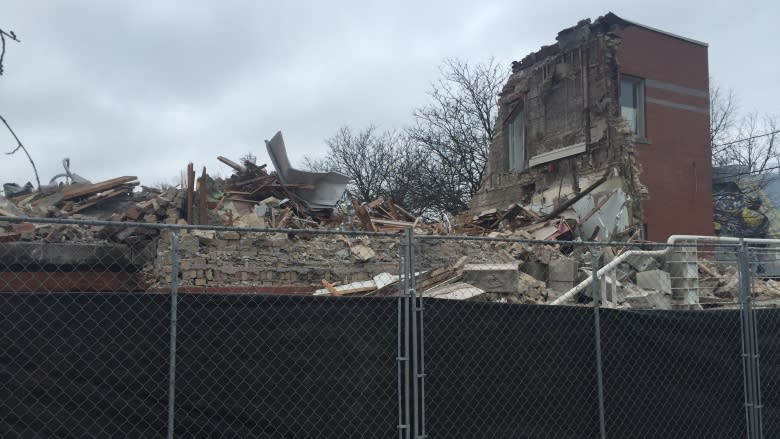Councillor, residents frustrated at demolition of 110-year-old building
The demolition of the beaux arts-style Bank of Montreal building that stood sentinel at Yonge Street and Roselawn Avenue for 110 years has underscored a gap in the city's legal ability to preserve heritage sites, Coun. Kristyn Wong-Tam says.
That's largely because the provincial Building Code Act allows commercial building owners to demolish a property without the city knowing what the next plans are for the site. You can't do that with your home, however.
"So there's no reason or mechanism for the city to refuse the demolition permit request by a commercial or industrial property owner," said Wong-Tam who represents Ward 27, Toronto Centre-Rosedale
"We just have to do it; that's the way the law works."
Same story, different building, Wong-Tam says
It's something she's fought to change since 2012. Then, the councillor asked city staff to designate the Victorian mansion on 81 Wellesley St. E. a heritage building — only to see it torn down a month later.
The city must approve a demolition permit within a matter of weeks, according to Building Code Act.
Designated heritage buildings, or cases where a site's materials might affect the surrounding environment, are the only exception when the city can reject an application.
But it takes a long time to gather the information to support a property's claim to historical importance.
In this case of the bank building at Yonge Street and Roselawn Avenue, members of the Lytton Park Residents' Organization were "99 per cent finished" the heritage application for 2444 Yonge St.
"But we didn't figure there was any rush," the group's director Linda McCarthy told CBC Toronto Monday.
That's because in 2014, the site's then-owner, KCAP Roselawn Inc., had submitted a rezoning application to the city.
While that proposal included plans for a five-storey mid-rise building, it promised to retain the bank and its facade on Yonge Street, according to a staff report in 2014. And it wouldn't be able to go ahead with plans without the city's approval.
"Heritage staff have taken an interest in protecting portions of the building as it has historical value," a city report said at the time.
New owners
But the building was sold to Roselawn and Main Urban properties Inc. in 2016, property records show. No one from the firm returned requests for comment from CBC Toronto.
The city received an application to demolish the Bank of Montreal building on Dec. 16. and last Wednesday, the city issued a permit, planning spokesman Bruce Hawkins said.
Residents found the building coming down on Saturday.
"I thought it was going to be preserved," Adrienne Stewart said, staring up at the building she's often walked by since moving to the neighbourhood 50 years ago. "You turn your back on something and suddenly it's gone."
Wong-Tam said she shares that frustration. It's the same way she felt in 2012 after 81 Wellesley St. E. was torn down — and again when the iconic Stollery Building on the southwest corner of Yonge Street and Bloor Street was demolished in 2015.
And she wants to see that legal loophole closed.
Wong-Tam said she feels that, as is, the Ontario Building Code Act doesn't allow enough time to designate a property a heritage site if it's already slated to be demolished.
The loophole
While the law may promote development, the councillor said that it's doing so at the expense of the cultural and historical landscape of a community.
"I think this is a challenge when you have two orders of government who are responding to the needs of the citizens in different ways," she said. "These beautiful old buildings ... tell the story of Toronto and Ontario by the way of design and architectural period, how they were built and the very significant events that took place in them.
"That's a very rich part of history that we have to preserve."
When asked in an email about how the Ontario Building Code protects heritage, a spokesman for the province said the city must follow the law in regards to demolition permits, which allows for exemptions in cases of registered heritage buildings.




